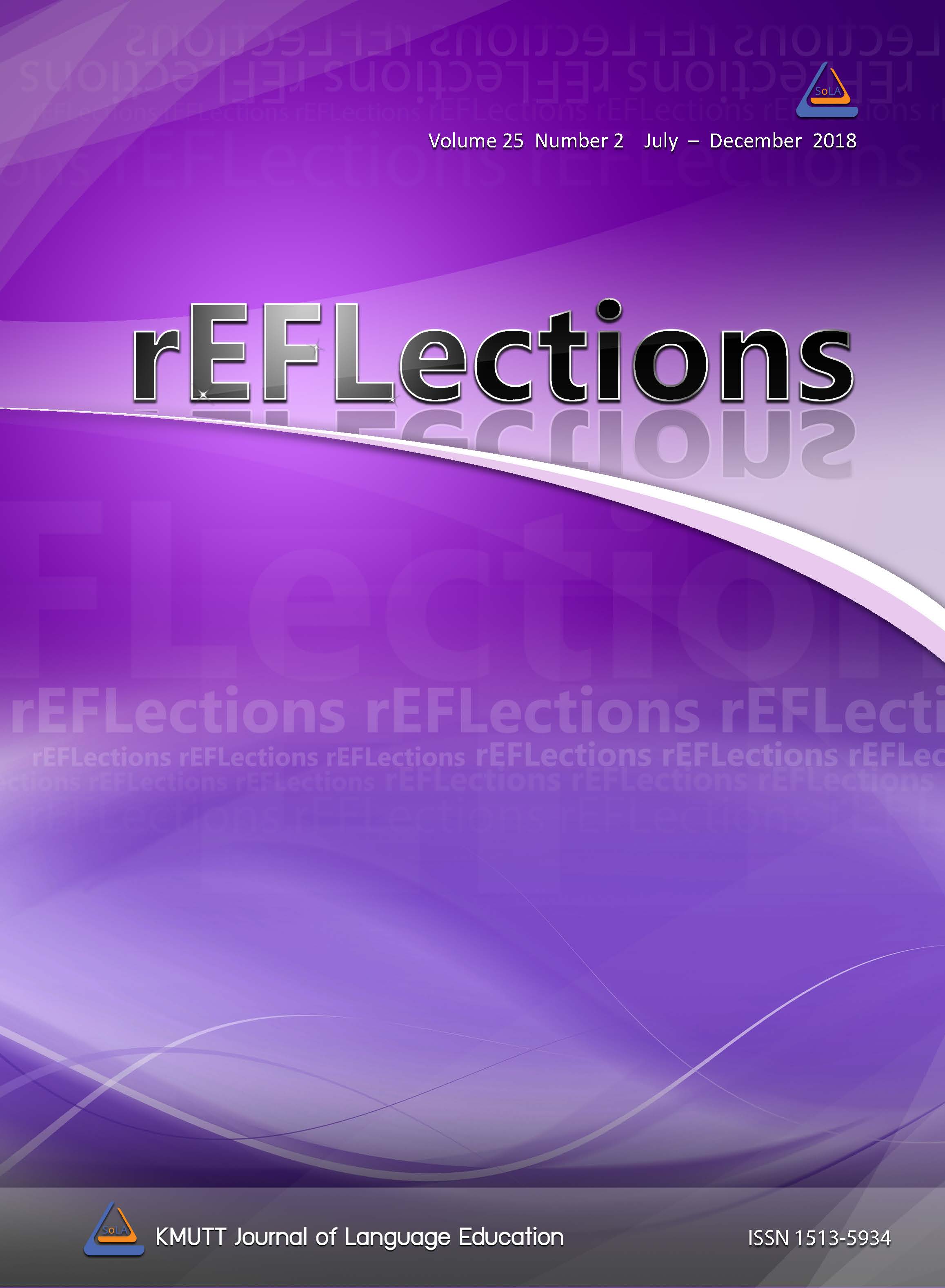Teachers’ Perceptions towards Promoting Intercultural Communicative Competence in the EFL Classroom
Main Article Content
Abstract
In language teaching, linguistic competence has typically been the main curricular focus. However, in this era of globalization, in which people from all over the world are interconnected, simply equipping learners with linguistic competence may not be sufficient. In addition, the effectiveness and appropriateness of communication play important roles in language learning. As a result, promoting intercultural communicative competence in the language classroom has become of interest to many scholars. This study was conducted to investigate the perceptions of EFL teachers towards promoting intercultural communicative competence (ICC) in EFL classes, and the strategies they use to promote ICC. The participants of the study included seven Thai teachers from an English for Workplace Communication course at KMUTT. The qualitative data from the semi-structured interviews was analyzed using Deardorff’s ICC framework (2006). The findings revealed that most of the teachers perceived ICC as the ability to communicate effectively and appropriately with people from different cultures, and the ability to be aware of cultural diversity. Desired external outcome, skills, knowledge and requisite attitude towards cultural differences are the aspects of ICC
that teachers have typically focused upon. Nonetheless, teachers have different perceptions towards culture, and as such their respective understandings of ICC vary slightly. The preferred strategies that most of the teachers used to promote ICC are anecdotes from the teachers’ direct experience, asking students to read and discuss, and student role-play. Role-play is the most effective way to promote ICC, in the teachers’ opinion.
Article Details
References
Bagarić, V., & Djigunović, J. M. (2007). Defining communicative competence. Metodika, 8(1), 94-103. Retrieved from https://hrcak.srce.hr/file/42651
Budharugsa, W. (2011). A perception of Thai EFL teachers towards intercultural competence teaching: A study of secondary schools in Chiang Mai province (Master’s thesis). Mahidol University, Thailand.
Byram, M. (1997). Teaching and assessing intercultural communicative competence. Clevedon, UK: Multicultural Matters.
Byram, M., & Feng, A. (2006). Living and studying abroad: Research and practice. Clevedon, UK: Multicultural Matters.
Byram, M., Gribkova, B., & Starkey, H. (2002). Developing the intercultural dimension in language teaching: A practical introduction for teachers. Strasbourg, Germany: Council of Europe.
Byram, M., & Risager, K. (1999). Language teachers, politics and cultures. Clevedon, UK: Multilingual Matters.
Canale, M., & Swain, M. (1980). Theoretical bases of communicative approaches to second language teaching and testing. Applied Linguistics, 1(1), 1-47.
Cheewasukthaworn, K., & Suwanarak, K. (2017). Exploring Thai EFL teachers’ perceptions of how intercultural communicative competence is important for their students. PASAA, 54, 177-204.
Chen, G.M., & Starosta, W.J. (1998). Foundations of intercultural communication. Boston, MA: Allyn and Bacon.
Chomsky, N. (1965). Aspects of the theory of syntax. Cambridge, MA: MIT Press.
Committee for Economic Development Research and Policy Committee. (2006). Education for global leadership: The importance of international studies and foreign language education for U.S. economic and national security. Committee for Economic Development. Retrieved from https://eric.ed.gov/?id =ED502294
Dai, X., & Chen, G.M. (2014). Intercultural communication competence: Conceptualization and its development in cultural contexts and interactions. Newcastle upon Tyne, UK: Cambridge Scholar Publishing.
Deardorff, D. K. (2004). Internationalization: In search of intercultural competence. International Educator, 13(2), 13–15.
Deardorff, D.K. (2006). Identification and assessment of intercultural competence as a student outcome of internationalization. Journal of Studies in International Education, 10(3), 241-266.
Deardorff, D.K. (2008). Intercultural competence: A definition, model and implications for education abroad. In V. Savicki (Ed.), Intercultural competence and transformation: Theory, research, and application, (pp.32-34). Sterling, VA: Stylus Publishing.
Fantini, A. E. (2000). A central concern: Developing intercultural competencies. Retrieved from https://agustinazubair.files.wordpress.com/2013/04/6-developing-intercultural-competence1.pdf
Fantini, A. E. (2010). Exploring multicultural competence: Defining, developing and monitoring. Retrieved from https://digitalcollections.sit.edu/cgi/viewcontent.cgi?article = 1105 &context=faculty_symposium
Gudykunst, W. B. (2005). Theorizing about intercultural communication. Thousand Oaks, CA: Sage.
Hofstede, G. (1984). Culture’s consequences: International differences in work-related values (2nd ed.). Beverly Hills, CA: SAGE Publications.
Hybels, S., & Weaver, R. L. (2004). Communicating effectively (7th ed). Boston, MA: McGraw-Hill.
Hymes, D. (1966). Two types of linguistic relativity. In W. Bright (Ed.), Sociolinguistics (pp. 114–158). The Hague, the Netherlands: Mouton.
Israelsson, A. (2016). Teachers’ perception of the concept of intercultural competence in teaching English (Master’s dissertation). Stockholm University, Sweden. Retrieved from https://urn.kb.se/resolve?urn =urn:nbn:se:su:diva-131353
Jata, E. (2015). Perception of lecturer on intercultural competence and culture teaching time (Case Study). European Journal of Interdisciplinary Studies, 3(1), 197-201.
Lázár, I. (2003). Incorporating intercultural communicative competence in language teacher education. Strasbourg, Germany: European Centre of Modern Languages - Council of Europe Publishing.
Miike, Y. (2010). Culture as text and culture as theory: Asiacentricity and its raison d’être in intercultural communication research. In T. K. Nakayama, & R. T. Halualani (Eds.), The handbook of critical intercultural communication (pp. 190-215). Oxford, England: Wiley-Blackwell.
OECD. (2009). Creating effective teaching and learning environments first results from TALI. Paris, France: OECD.
Pajares, M. F. (1992). Teachers’ beliefs and educational research: Cleaning up a messy construct. Review of Educational Research, 62(3), 307-332.
Rogers, M. E., & Steinfatt, T. M. (1999). Intercultural communication. Prospect Height, IL: Waveland Press.
Schoeffel, V. (2007). Intercultural Communication I. Retrieved from https://www.ymca.int/fileadmin/library/6_Communications/1_General_Tools/Intercultural_Communication_1.pdf
Trede, F., Bowles, W., & Bridges, D. (2013). Developing intercultural competence and global citizenship through international experiences: Academics’ perceptions. Intercultural Education, 24(5), 442-455.
Weaver, G. R. (1986). Understanding and coping with cross-cultural adjustment stress. In R.M. Paige (Ed.), Cross-cultural orientation: New conceptualizations and applications (pp. 177-194). Lanham, MD: University Press of America.
Wiseman, R. L. (2002). Intercultural communication competence. In W.B. Gudykunst, & B. Mody (Eds.), Handbook of international and intercultural communication (pp. 207-224). Thousand Oaks, CA: Sage.
Young, T. J., & Sachdev, I. (2011). Intercultural communicative competence: Exploring English language teachers’ beliefs and practices. Language Awareness, 20(2), 81-98. Retrieved from https://doi.org/10. 1080/09658416.2010.540328


